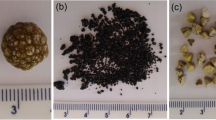Abstract
Gallstone disease is a major health problem in many parts of the world. In Nigeria, however, only a few cases of gallstone disease are reported. Minor/trace elements are reported to play a significant role in the formation of gallstones. This study was conducted to assess the minor elements in gallstone of Nigerian patients who had cholecystectomy in our institution using particle-induced X-ray emission (PIXE) technique. We also compare the findings with previous reports from outside Nigeria. Fourteen patients who had cholecystectomy for calculous cholecystitis at Obafemi Awolowo University Teaching Hospital Complex, Ile-Ife, Nigeria, between March 2006 and July 2008, had the stone retrieved. The stones were analyzed for trace elements at the Center for Energy Research and Developments of the University using PIXE experiments. Certified standard reference material, NIST 1577a (bovine liver), was equally analyzed to confirm the accuracy of the experimental procedure. Computer code GUPIXWIN was used to analyze the data. Fourteen elements, phosphorus, sulfur, chlorine, potassium, calcium, manganese, iron, copper, zinc, bromide, lead, titanium, rubidium, and strontium, were detected in most of the samples. The concentrations of the elements varied in the different samples, ranging from a few parts per million to a few percent. Ca was the major constituent of all samples. The black sand-like samples had very high levels of P, S, K, and Pb, which were different from a previous report. The distribution of trace elements in stones in Nigeria patients is different from previous report outside Nigeria, and this may have some role in the occurrence of gallstones in the black African.





Similar content being viewed by others
References
Ashok M, Rautray TR, Nayak PK, Vijayan V, Jayanthi V, Kalkura SN (2003) Energy dispersive X-ray fluorescence analysis of gallstones. J Radioanal Nucl Chem 257:333–335
Channa NA, Khand F, Ghanghro AB, Mahessar H, Soomro AM (2008) Comparative study of sodium and potassium in different types of gallstones and in serum of subjects with gallstones and controls. Pak J Anal Environ Chem 9:38–42
Acalovschi M (2001) Cholesterol gallstones: from epidemiology to prevention. Postgrad Med J 77:221–229
Everhart JE, Khare M, Hill M, Maurer KR (1999) Prevalence and ethnic differences in gallbladder disease in the United States. Gastroenterology 117:632–639
Darko R, Archampong EQ, Qureshi Y, Muphy GM, Dowling RH (2000) How often are Ghananian gallbladder stones cholesterol-rich. West Afr J Med 19(1):64–70
Trotman BW (1991) Pigment gallstone disease. Gastroenterol Clin North Am 20:111–126
Uchiyama K, Kawai M, Tani M, Terasawa H, Tanimura H, Yamaue H (2007) Pathogenesis of hepatolithiasis based on the analysis of components of intrahepatic stones. Hepatogastroenterology 54:1798–1804
Carey MC (1993) Pathogenesis of gallstones. Am J Surg 165:410–419
Kim MH, Sekijima J, Lee SP (1995) Primary intrahepatic stones. Am J Gastroenterol 90:540–548
Rautray TR, Vijayan V, Ashok M, Kennedy JV, Jayanthi V, Ibrarullai MD, Panigrahi S (2005) Pixel analysis of gallstone. Int J PIXE 15:147–152
Okumuşoğlu NT, Korkmaz F, Birchall J (2006) PIXE analysis of gallstones from Turkish patients. Nucl Instrum Methods Phys Res A 562:1054–1056
Strasberg SM (2008) Acute calculous cholecystitis. N Engl J Med 358:2804–2811
Kleiner O, Ramesh J, Huleihel M, Cohen B, Kantarovich K, Levi C, Polyak B, Marks RS, Mordehai J, Cohen Z, Mordechai S (2003) A comparative study of gallstones from children and adults using FTIR spectroscopy and fluorescence microscopy. BMC Gastroenterol 2:3
Sanders G, Kingsnorth AN (2007) Gallstones. BMJ 335:295–299
Ehiawaguan PI, Enukegwu S, Osime C (2008) Epidemiology of gallstone disease in Benin City, Nigeria. Niger J Surg 14:1–6
Akute OO, Obajimi MO (2002) Cholelithiasis in Ibadan: an update. West Afr J Med 21:128–131
Gokulakrishnan S, Ashok M, Jayanthi V (2001) Analysis of gallstone—critical appraisal of various techniques. Gastroenterol Today 5:145–148
Abboud IA (2008) Concentration effect of trace metals in Jordanian patients of urinary calculi. Environ Geochem Health 30:11–20
Salimi J, Moosavi K, Vatankhah S (2003) The concentration of heavy trace elements in pigment and cholesterol human gallstones: comparative studies by PIXE analysis. Iran J Radiat Res 1(2):93–97
El-amri FA, Barouni GA (1993) Trace element concentration in human gallstones using instrumental neutron activation analysis. J Radioanal Nucl Chem 174:29–33
Pundir CS, Chaudhary R, Rani K, Chandran P, Kumari M, Garg P (2001) Chemical analysis of biliary calculi in Haryana. Indian J Surg 63:370–73
Chandran P, Kuchhal NK, Garg G, Pundir CS (2007) An extended chemical analysis of gallstone. Indian J Clin Biochem 22:145–150
Chandran P, Garg P, Pundir CS (2005) Correlation between chemical components of biliary calculi and bile & sera and bile of gallstone patients. Indian J Clin Biochem 20:81–85
Verma GR, Pandey AK, Bose SM, Prasad R (2002) Study of serum calcium and trace elements in chronic cholelithiasis. ANZ J Surg 72:596–599
Amin AM, Ananthakrishnan N, Nambinarayanan TK (2000) Composition of gallstones and Sequential events in biliary lithogenesis—is it different in South India compared to north? J Assoc Physicians India 48:885–890
Barksdale J. The encyclopedia of the chemical elements. Skokie, Illinois: Reinhold Book Corporation 1968:732–38 Titanium. LCCCN 68-29938
Sharat-Singh NK, Sharma HNK, Sudarshan M, Chakraborty A (2006) PIXE studies of some human stones. Int J PIXE 16:21-27
Ololade IA, Adewunmi A, Ologundudu A, Adeleye A (2009) Effects of household wastes on surface and undergound waters. Int J Phys Sci 4:22–29
Nduka JK, Orisakwe OE (2007) Heavy metal levels and physico-chemical quality of potable water supply in Warri, Nigeria. Ann Chim 97:867–874
Pfitzner MA, Thacher TD, Pettifor JM, Zoakah AI et al (2001) Prevalence of elevated blood lead levels in Nigerian children. Ambul Child Health 6:115–123
Author information
Authors and Affiliations
Corresponding author
Rights and permissions
About this article
Cite this article
Alatise, O.I., Obiajunwa, E.I., Lawal, O.O. et al. Particle-Induced X-ray Emission (PIXE) Analysis of Minor and Trace Elements in Gallstones of Nigerian Patients. Biol Trace Elem Res 134, 13–24 (2010). https://doi.org/10.1007/s12011-009-8453-3
Received:
Accepted:
Published:
Issue Date:
DOI: https://doi.org/10.1007/s12011-009-8453-3




